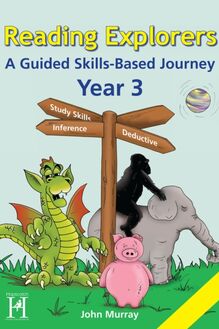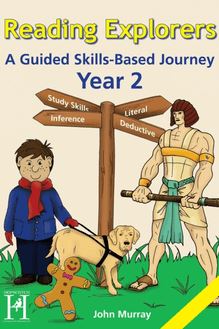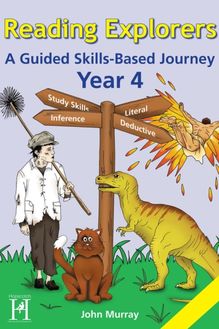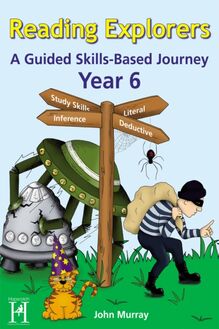Reading Explorers Year 2 , livre ebook
218
pages
English
Ebooks
2014
Vous pourrez modifier la taille du texte de cet ouvrage
Obtenez un accès à la bibliothèque pour le consulter en ligne En savoir plus
Découvre YouScribe en t'inscrivant gratuitement
Découvre YouScribe en t'inscrivant gratuitement
218
pages
English
Ebooks
2014
Vous pourrez modifier la taille du texte de cet ouvrage
Obtenez un accès à la bibliothèque pour le consulter en ligne En savoir plus
Publié par
Date de parution
20 novembre 2014
Nombre de lectures
1
EAN13
9781907515736
Langue
English
Poids de l'ouvrage
2 Mo
Publié par
Date de parution
20 novembre 2014
Nombre de lectures
1
EAN13
9781907515736
Langue
English
Poids de l'ouvrage
2 Mo
Title page
Reading Explorers
A Guided Skills-Based Journey
Year 2
John Murray
Publisher information
Originally published by
Hopscotch, a division of MA Education,
St Jude’s Church, Dulwich Road,
London, SE24 0PB
www.hopscotchbooks.com
020 7738 5454
© 2009 MA Education Ltd.
2014 digital version by Andrews UK Limited
www.andrewsuk.com
Written by John Murray
Illustrated by Emma Turner, Fonthill Creative, 01722 717057
John Murray hereby asserts his moral right to be identified as the author of this work in accordance with the Copyright, Designs and Patents Act, 1988.
All rights reserved. This resource is sold subject to the condition that it shall not, by way of trade or otherwise, be lent, hired out or otherwise circulated without the publisher’s prior consent in any form of binding or cover other than that in which it is published and without a similar condition, including this condition, being imposed upon the subsequent purchaser.
No part of this publication may be reproduced, stored in a retrieval system, or transmitted, in any form or by any means, electronic, mechanical, photocopying, recording or otherwise, without the prior permission of the publisher.
Every effort has been made to trace the owners of copyright of material in this book and the publisher apologises for any inadvertent omissions. Any persons claiming copyright for any material should contact the publisher who will be happy to pay the permission fees agreed between them and who will amend the information in this book on any subsequent reprint.
Extract from The Oxford First Dictionary (OUP, 2002), reprinted by permission of Oxford University Press.
Introduction
About this series
Reading Explorers - A Guided Skills-Based Programme is a self-contained programme of work which has been developed to enhance the teaching and learning of guided reading.
It aims to provide teachers with a scheme of work that will enhance the development and continuity of guided reading throughout the school. More importantly, the programme actively promotes the teaching and learning of specific reading and study skills. The children thus acquire the ability to access, interpret and understand a piece of text, and are encouraged to become more independent thinkers and learners.
The main reason for the programme’s success is that it is a skills-based programme which fulfils the needs of the developing learner. The pupils themselves are aware of the specific skills they are hoping to achieve each half term and are actively involved in developing these skills through the use of wipe board and kinaesthetic activities. They are also taught how to analyse the question being asked before they attempt to look for an answer. With this approach, teachers can support the children as they become independent learners in a structured and progressive manner.
The five thinking and reasoning skills contained in this programme are as follows:
Literal thinking
Deductive reasoning
Inferential skills
Evaluative assessment of texts
Study skills which promote wider independent study
There are five books in the series, one book per year group from Year 2 to Year 6.
Year 2 (Ages 6-7)
Year 3 (Ages 7-8)
Year 4 (Ages 8-9)
Year 5 (Ages 9-10)
Year 6 (Ages 10-11)
Each book aims to: support teachers by providing a programme of work that covers enough lessons for a whole year reduce teachers’ preparation time through the provision of differentiated activities and resources develop children’s comprehension skills through purposeful and stimulating activities provide children with the opportunity to access a range of different texts and genres, as outlined in The National Literacy Strategy.
About this book
This book is for teachers of children in Year 2 and includes the following: A planning matrix of the skills to be taught throughout the series. A contents page that gives an overview of which skill a particular text is encouraging. Six detailed lesson plans with accompanying photocopiable texts for each half term (36 in total). A resources section.
The Resources section
This provides differentiated text for each lesson plan. It also contains supporting resource materials which will prove useful when delivering each lesson.
The main text in each book is aimed at the average reading ability of the children of this age range. The texts provided in the Resources section are at a level below and a level above the texts in the book. This will allow all children within the classroom setting to access both the text and the specific reading or study skill being taught during each half term.
The planning matrix
A planning matrix is provided immediately after the Sample Lesson Plan. Each P symbol represents how often a particular skill should be taught during each academic year. Each P symbol = 1 half term lasting approximately 6 weeks.
The contents page
Once a skill has been chosen to teach, the teacher can then choose an appropriate lesson within the specific reading skill. As the lessons within each skill are self-contained, they can be undertaken in any order.
Lesson plans
The book contains 36 lessons - enough for six per half term. The heading of each section indicates the specific skill to be taught and practised in each lesson. The lesson plans are divided into four sections: Warm up questions
This part should be carried out first. The questions are usually literal, their purpose being to orientate the children with the text provided. Main questions
This is the main body of the lesson and the types of questions posed here relate directly to the skill being practised.
The same questions can be used with all three texts for each lesson and, where appropriate, the answers are provided in brackets. Essential Vocabulary
These questions or activities support the Main Questions section. They increase children’s knowledge and understanding of words and help promote an understanding of why certain words were chosen by the author. Evaluative questions
This section does more than simply help the teacher to round off the lesson. It allows children to speculate on the tone and purpose of the text, as well as to consider the text’s audience. It also enables teachers to ask further questions on the social relevance a text may have in today’s society.
Important information to read before carrying out the lesson plans
How to prepare and carry out the lessons
You will need: A wipe board and pen Any prompt cards associated with your learning aim (see below)
The children will need: A wipe board and pen A photocopy of the reading text A highlighter pen
Introducing the session to the children
First, settle your reading group and make sure each child has a wipe board, a dry marker and a highlighter pen. It is important that the children know which reading or study skill they are focusing on throughout each half term. Specific learning objectives should be discussed with the children at the beginning of each half term and you can remind them of these at the beginning of each session. A model is provided below: Who can tell me what type of questions we are focusing on this half term?
- Deductive Good. (The teacher now sticks the deductive symbol* on the board) And what did we say the word deductive sounds like?
- Detective Well done. So as a detective, what do we have to look for?
- Evidence, clues, proof And where will we find this evidence?
- We can highlight words or sentences on our sheet. Well remembered. I think you’ve earned your detective badge now and we can begin. (The teacher now gives each child their own pre-prepared detective badge* to wear during the lesson).
* Icon included in the Resources section
It is important to write the children’s answers up so they can be clearly seen throughout your lesson. This will act as a visual reminder to each child of what their learning intention is - not simply for this lesson but for the whole half term.
Below are examples of the symbols you may wish to use to represent each skill. Over time, the children will recognise and associate each symbol with its relevant skill, especially if the same symbols are used throughout the school.
Icons included in the Resources section
Prior to reading the text
Provide the children with a copy of the text and ask them to scan the page to look for clues which tell them what type of text it is. Is it fiction or non-fiction? What genre of text is it? How can they tell this?
What do they think the text might contain? Ask them to look at the illustrations, title, headings, sub-headings and layout to give them clues. Can they predict what the text will be about? What do they already know about this particular genre?
Ask the children to quietly read through the text to familiarise themselves with it. They can circle any unfamiliar words they encounter. Any words circled can be discussed as a group and, later on, be put into the children’s personal dictionaries. These can either be used to provide vocabulary extension work for particular groups or can provide extra words for their weekly spellings.
The warm up questions (3-5 minutes)
Next, ask the questions contained in the ‘warm up’ part of the lesson plan. This will give the children a purpose for their reading of the text and will enable them to search for specific information as they read. By doing this, the children



